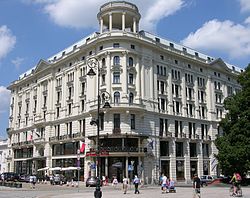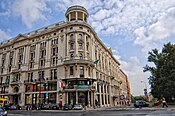Hotel Bristol, Warsaw
| Hotel Bristol, Warsaw | |
|---|---|
 Hotel Bristol, Warsaw (2011) | |
 | |
| General information | |
| Architectural style | Neo-Renaissance |
| Location | Warsaw, Poland |
| Address | Krakowskie Przedmiescie 42/44 |
| Opening | November 19, 1901 |
| Owner | Towarzystwo Akcyjne Budowy i Prowadzenia Hotelów, (1901-1928), Bank Cukrownictwa (1928-1948), City of Warsaw (1947-1952), Orbis (1952-1977), University of Warsaw (1977-1981), Orbis (1981-2011), Rosmarinum Investments (2011-) |
| Management | Marriott International |
| Design and construction | |
| Architect(s) | Władysław Marconi |
| Other information | |
| Number of rooms | 165 |
| Number of suites | 41 |
| Website | |
| www.hotelbristolwarsaw.pl | |
| Designated | 1994-09-08 |
| Part of | Warsaw – historic city center with the Royal Route and Wilanów |
| Reference no. | M.P. 1994 nr 50 poz. 423[1] |
Hotel Bristol, Warsaw is a historic five-star luxury hotel built in the Neo-Renaissance style and opened in 1901 in Warsaw, Poland. It is located in the city centre on Krakowskie Przedmieście next to the Presidential Palace.
The hotel is one of the most notable historic monuments of the Royal Route (Polish: Trakt Królewski) and remains among the few landmarks of Warsaw which emerged relatively unscathed from the city's near total destruction during World War II.[2][3] It is considered as one of Warsaw's oldest and one of the country's most luxurious hotels.
History
[edit]
The Hotel Bristol was constructed from 1899-1900 on the site of the Tarnowski Palace by a company whose partners included Polish pianist Ignacy Jan Paderewski. A competition was held for the design of the building, and architects Tadeusz Stryjeński and Franciszek Mączyński won with their Art Nouveau design. However the builders decided to change the style to a Neo-Renaissance design, and brought in architect Władysław Marconi to design the final hotel. Some of its interiors were designed by the noted Viennese architect Otto Wagner Jr. The cornerstone was laid on April 22, 1899 and the hotel was dedicated on November 17, 1901 and opened on November 19, 1901.[4] Among the notable features of the newly-built hotel was the country's first elevator.[5] The hotel also housed the photo studio of Jadwiga Golcz[6] which was frequented by many well-known artists of the time.[7]

After Poland gained its independence in 1919, Paderewski became the Prime Minister and held the first session of his government at his hotel. Paderewski and his partners sold their shares in the hotel in 1928 to Bank Cukrownictwa, a local bank which renovated the hotel in 1934 with modern interiors by designer Antoni Jawornicki. In the 1930s, one of the hotel rooms on the fifth floor served as an atelier of painter Wojciech Kossak.[8]
Upon the German invasion in 1939, the hotel was made into the headquarters of the Chief of the Warsaw District. It miraculously survived the war relatively unscathed, standing nearly alone among the rubble of its neighborhood. Following the war, the hotel was renovated and reopened in 1945.

The City of Warsaw took over operation of the hotel in 1947 and it was nationalized in 1948 and joined the state-run Orbis chain in 1952, exclusively serving visitors from abroad. In 1965, the hotel was inscribed onto the Registry of Cultural Property.[9] By the 1970s its outdated facilities had seen it demoted to a second class ranking by the government and the hotel was donated by Prime Minister Piotr Jaroszewicz to the University of Warsaw in 1977 to eventually serve as their library. It closed in 1981. However no work was done and the building languished through the waning days of the Communist government.
After the fall of Communism in 1989, the hotel was finally completely restored to its former glory from 1991-1993, with the original interiors of the public rooms recreated to match the 1901 designs.[10] The Bristol was reopened on April 17, 1993, with Margaret Thatcher in attendance, as part of the British Forte Hotels chain. From 1998 to 2013, the hotel was part of the Le Méridien hotel chain and was known as Le Royal Méridien Bristol. The exterior was further restored in 2005, and the interior redecorated in 2013, after which the hotel joined The Luxury Collection. Currently, the hotel offers 165 rooms as well as 41 suites.[11]
Famous guests
[edit]Throughout its long history, the Hotel Bristol was visited by a number of prominent guests from all over the world, some of which include:[12][13][14][15][16][17][18][19]
- Woody Allen
- Paul Anka
- Eugeniusz Bodo
- George H. W. Bush
- José Carreras
- Enrico Caruso
- Naomi Campbell
- Ray Charles
- Jacques Chirac
- Marie Curie
- Dalai Lama
- Gerard Depardieu
- Marlene Dietrich
- Elizabeth II
- Margot Fonteyn
- Dave Gahan
- Bill Gates
- Günter Grass
- Edvard Grieg
- Herbert Hoover
- Mick Jagger
- John Fitzgerald Kennedy
- Jan Kiepura
- Helmut Kohl
- Sophia Loren
- Paul McCartney
- Angela Merkel
- Pablo Neruda
- Jacqueline Kennedy Onassis
- Ignacy Jan Paderewski
- Pablo Picasso
- Józef Piłsudski
- Michel Platini
- Lionel Richie
- Artur Rubinstein
- Richard Strauss
- Karol Szymanowski
- Wisława Szymborska
- Margaret Thatcher
- Tina Turner
Gallery
[edit]-
Hotel Bristol on the corner of Karowa Street and Krakowskie Przedmieście
-
Illumination of the hotel
-
Hotel Bristol in 2006 before renovation
-
Main entrance
-
A historic image of Hotel Bristol in Warsaw, 1910
-
Hotel lobby
-
A bust of Ignacy Paderewski
-
The Malinowa Hall
See also
[edit]References
[edit]- ^ Zarządzenie Prezydenta Rzeczypospolitej Polskiej z dnia 8 września 1994 r. w sprawie uznania za pomnik historii., M.P., 1994, vol. 50, No. 423
- ^ "Poland: The Historic Hotel Bristol". Retrieved 10 September 2022.
- ^ "Hotel Bristol: Poland's Most Iconic Hotel Reviewed". 15 December 2015. Retrieved 10 September 2022.
- ^ "Capital's 'grand dame of hospitality', the Hotel Bristol celebrates its 120th birthday". Retrieved 20 November 2021.
- ^ "Hotel Bristol: Poland's Most Iconic Hotel Reviewed". Retrieved 11 September 2022.
- ^ "Fotografowie - Galeria Fotografii Towarzystwa Opieki nad Zabytkami Przeszłości w zbiorach IS PAN". Towarzystwo Opieki nad Zabytkami Przeszłości. Retrieved 2023-01-17.
- ^ "Świat w obiektywie kobiet". Polskie Radio (in Polish). Retrieved 2023-01-17.
- ^ Omilanowska, Małgorzata; Majewski, Jerzy S. (2000). Warszawa Przewodnik. Warsaw: Wiedza i życie. p. 119. ISBN 83-7184-861-7.
- ^ "Rejestr zabytków" (in Polish). Retrieved 11 September 2022.
- ^ "Poland: The Historic Bristol Hotel". Retrieved 19 July 2021.
- ^ "Hotel Bristol, A Luxury Collection Hotel, Warsaw" (in Polish). Retrieved 11 September 2022.
- ^ "Hotel nad hotele. Bristol to nazwa, która w głowach musuje jak szampan". Retrieved 2019-02-15.
- ^ "Hotel Bristol w Warszawie dołączył do grupy The Luxury Collection! Mnóstwo zdjęć odnowionej architektury i architektury wnętrz". Retrieved 2019-02-15.
- ^ "Hotel Bristol - przystań dla wielkich i sławnych tego świata". Retrieved 2019-02-15.
- ^ ""Goście Honorowi" w Hotelu Bristol. Zobacz sławy stolicy na zaskakującej wystawie". Retrieved 2019-02-15.
- ^ "Hotel Bristol został sprzedany". Retrieved 2019-02-15.
- ^ "HISTORIA POLSKICH HOTELI. 100 lat tradycji warszawskiego BRISTOLU". Archived from the original on 2019-02-16. Retrieved 2019-02-15.
- ^ "Hotel Bristol, świadek historii Warszawy". Retrieved 2019-02-15.
- ^ "Luksusowe hotele przedwojennej Warszawy i ich historia. W jednym z nich spał Napoleon, a trzy działają nadal". Retrieved 2019-02-17.
External links
[edit]![]() Media related to Hotel Bristol in Warsaw at Wikimedia Commons
Media related to Hotel Bristol in Warsaw at Wikimedia Commons








